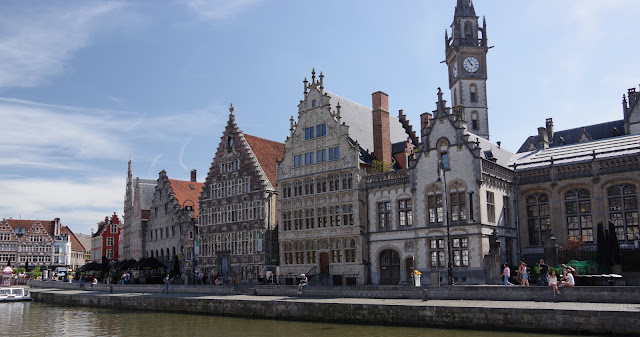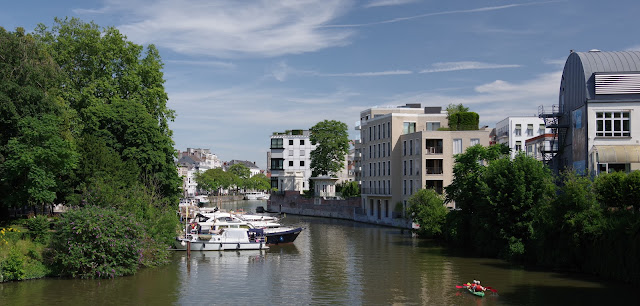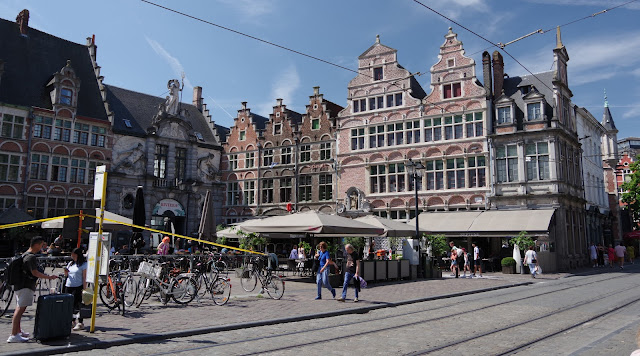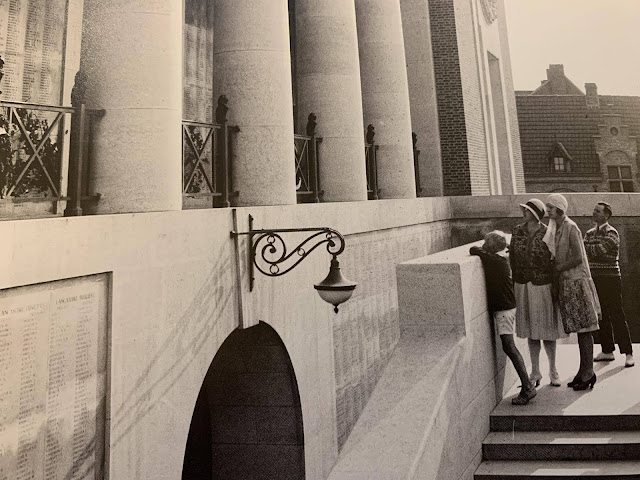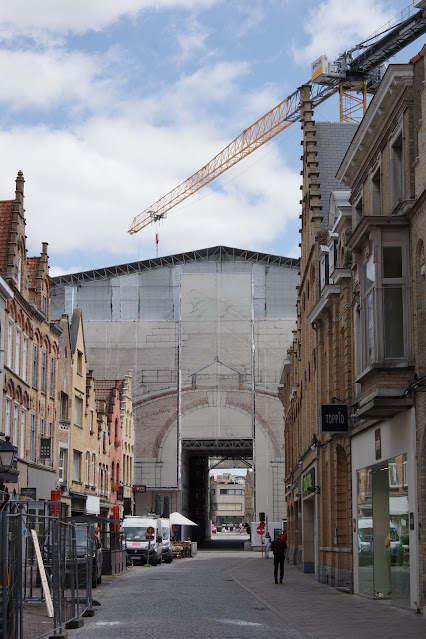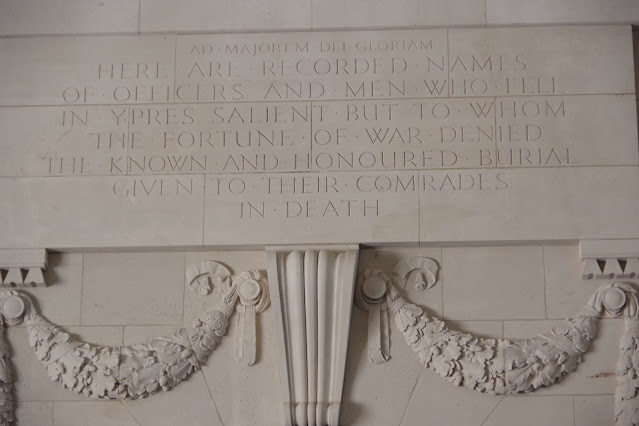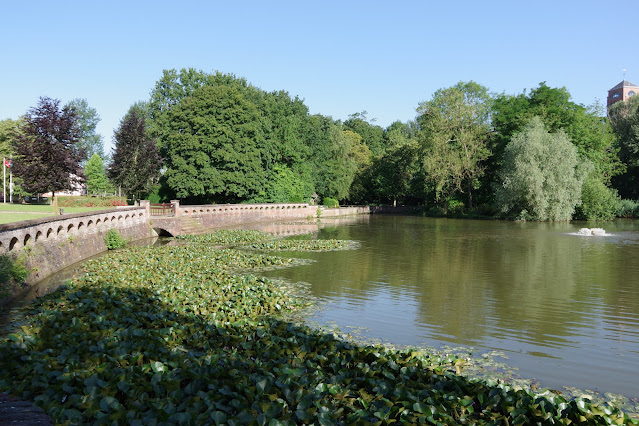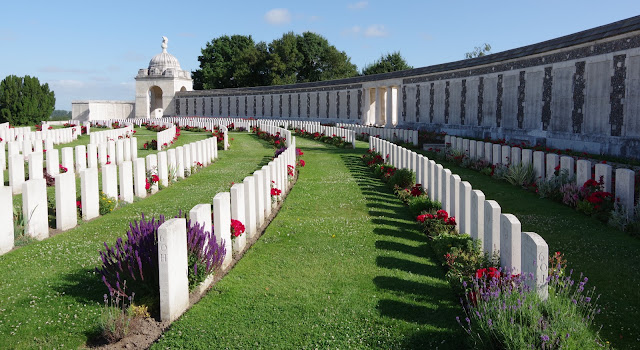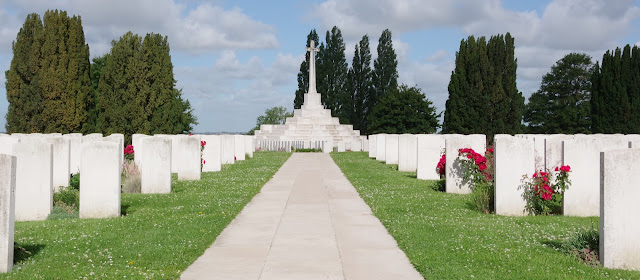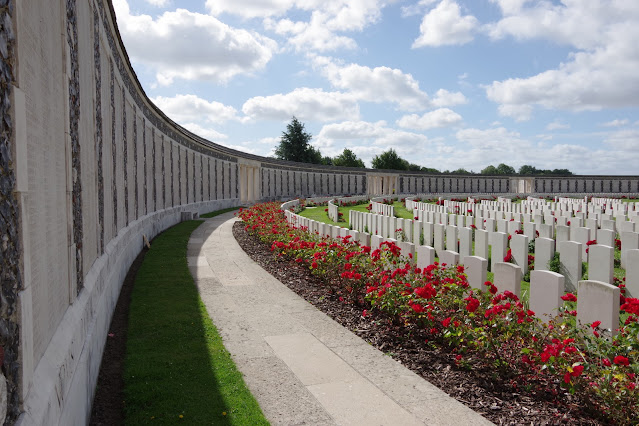…. the air
is soft, but over one hundred years ago the air was dense with smoke, filled
with the cries of men, the crack of rifle fire and the roar of cannon. In the
trenches death was a constant companion, a partner in life.
This
afternoon having left Ypres in Flanders, Belgium, I am now in London for one
night before my flight to Halifax tomorrow afternoon. It is the end of a
fantastic four weeks doing many things I have always wanted to do in Scotland,
Belgium, The Netherlands and France. I have fulfilled my obligated duty as
their son and took my parent’s home, to a stunning location in the Scottish
Highlands, a place they both loved so much.
I can
say in this final blog of "Euro 2024", that over the last 28 days, I did
everything I had planned to do, all the boxes were ticked. During my time away,
I explored remote little corners of Scotland I had never seen before, while
renewing my acquaintances with others. I was welcomed again into the
beautiful home of my high-school buddy Shuna and her husband Ken, I spent three
great nights in Blairmore, Argyllshire visiting my dad’s cousin May, I visited
the WWI war grave of my grand-uncle in Glasgow, and had the joy of reconnecting
with friends from my past and along the way made new ones. On my travels in Belgium, The Netherlands and France, I met some
really interesting people, stayed in great accommodations and stopped at
locations that deserve to remain in my memory forever ~ I can honestly say, although it was tiring at times, I thoroughly enjoyed every minute of this past month.
Within
the recent blogs written during my time in mainland Europe, I tell of my
travels to Leopoldsburg and Wuustwezel in Northern Belgium, Steenbergen in The
Netherlands, of the peaceful rolling landscapes of The Somme in France and then
onto Ypres in Flanders, Belgium. I have spent precious time combined with
moments of deep thought and reflection at the war graves of three from my
family, two killed during WWI and one from WWII. I have had the privilege while
on the road of visiting many CWGC memorials and perfectly manicured cemeteries.
Each one of those stops had a powerful affect upon me, triggering deep
emotions, in the same way as they did on a similar pilgrimage with my parents
24 years ago. It is a special and unparalleled experience to see the rows of
gravestones perfectly in line with a deliberate military precision, as if the
fallen were still on parade. Then there are the vast and dominating memorials,
which frequently and without warning break the rolling landscapes, built in
honour the “lost”. Great structures inscribed with the tens of thousands of
names, that a ruinous industrialized war denied the civility of a known grave.
There were many more cemeteries and memorials I did not stop at. It would be impossible in the time I had to pull over at them all, to walk between the endless rows of white gravestones and pause at each grave, or stop at the dozens or perhaps hundreds of memorials I passed on the road, many to commemorate the sites of WWI battles. I felt a sense of enormous guilt at driving past them, and not taking just a moment to offer my thanks and acknowledgment for their missed years and absent life experiences that we all take for granted, or to consider their grieving families and loved ones they left behind.
In the
haste of my three-night visit to Belgium and France back in April 2000, I wrote
brief notes to myself as a reminder of my feelings and thoughts about what I
had seen and experienced. Upon my return to Canada, I expanded on those notes
and kept them safe until years later, when I included them in a couple of blogs I
wrote during February and October 2017. Below are some of those expanded notes from 24
years ago, which describe perfectly all I could possibly say about my journey over the
last few days.
8th April, 2000 ~ Visiting Hugh Wright at Leopoldsburg War Cemetery,
Limburg, Belgium ....
"In my life I have walked
around more than a few gravesites, many of those times when I was much younger
with my dad. We would wander in churchyards always curious to find the oldest
gravestone and randomly with much interest read inscriptions. Later I would do
the same on my own, but this time it was the task of finding relatives during
my family tree research. Those graveyards, whether they were community or
church, could most of the time be best described as random with no sign of
thought, lacking order or deliberate plan. They seemed loud, mostly disturbed,
never at peace, always affected by the bustle and flurry of the surrounding
daily activities.
Until that day in April
2000, I had never before experienced a Commonwealth War Graves Commission
cemetery. I had seen photographs showing the typical impressive display of neat
rows of regimented uniformity, the gravestones assembled like soldiers on the
parade ground. But what I was not prepared for was the instant and overwhelming
emotion, the complete tranquility, the awesome sense of stillness and the
enormous feeling of being someplace extremely special. I will never be able to
fully or accurately describe to anyone who has not had the privilege and honour
to visit such a site, how profoundly moving the experience was. I remember
clearly the moment I walked through the entrance gate, sensing that I had
entered an environment of total peace, disturbed only by the sounds of spring,
birds chirping and leaves gently moving in the soft warm wind. I had never
before experienced such a feeling of complete serenity. Then for reasons which
remain unclear, as if by hand I was led to Grave 12, in Row A of Plot V, to the
resting place of my first cousin once removed Hugh Wright. To see the name
“Wright” engraved on that white stone was a unique and strange combination of
sheer pride that was quickly tempered by enormous sadness.
On that day, the 8th April
2000, I did not leave the warm comforting stillness of the cemetery until I
paid my own personal gratitude to all of the 767 souls who lie in perpetuity
within its grounds. It took me over four hours to spend a moment at every one
of those gravestones. I read all the personal inscriptions and paused a little
longer at those who are only ~ “Known Unto God”. I did this because I had too;
I owed each and every one a moment of thanks and reflection.
I remember one poignant
message engraved onto the gravestone of Private David Sprott of The Kings Own
Scottish Borderers who died on the 25th December 1944 aged 28 ~ “A LITTLE
CORNER OF A FOREIGN LAND THAT IS FOREVER SCOTLAND”, quite possibly the chosen words
of his proud parents David and Christina Hynd Sprott of Crosshouse, Ayrshire.
I was struck by the ages
of those in the cemetery, every one of them much younger than I was. I thought
of myself at their tender age, I was moved and impressed by the depth of
responsibility, the call to duty and the sacrifice they each had made, I then
questioned if I could have done the same. No longer were those guys merely
images in a grainy black and white newsreel film from a long time ago, they
were here and this was real. As I looked across this wondrous place, I
reflected upon the backyard chat I had with my dad years prior. I thought about
the tears he shed that afternoon for his cousin Hugh, who had died many decades
before and now within the surrounding quietness the very same was happening to
me. My tears were not only for Hugh, but for all those who lay before me in
Leopoldsburg, many of whom were vast oceans away from home. As I looked around
at the tremendous loss, I felt incredible emotion, the impact was enormous. I
will never allow myself to forget what each of those souls had given up, the
missed years, the daily life experiences that we take for granted, the loved
ones left behind and the biggest tragedy of all, the many young children who
never got to know their father.
I remember in late 1999
while the planning the trip to Belgium I often thought in complete ignorance,
it was a great shame that Hugh had never been brought home to Glasgow. I felt
that it would have been correct and right for him to have been buried close to
his father, a place where his mother and sister could have visited and cared
for. Those thoughts all changed in an instant with my unforgettable visit to
Leopoldsburg. Being thoroughly struck by the beauty and tranquility of the
cemetery, reading the inscriptions on each gravestone, which evoked images of
mothers and fathers lamenting lost sons, wives mourning their husbands combined
with the thoughts of young children growing up without fathers, I left
Leopoldsburg with the comforting fact that out of the bitterness of war, Hugh
had found perfect peace buried among his comrades, who all endured an equally
tragic loss. I felt secure in the knowledge that their graves would always be
respected and cared for, therefore this is the rightful place he should be."
9th April 2000 ~ The journey to John Kerr at Hamel Military Cemetery, The Somme, France ...
"The journey to Hamel
Village took us on many narrow remote winding roads that were often interrupted
by what can be best described as casual small intersections. At those stops on
the road there are basic signposts with arrows pointing in all directions indicating
Commonwealth War Grave Commission sites. Often those signposts were
supplemented with words Canadian, British, South African, Australian or New
Zealand indicating the dominant nationality at each site. When taking
directions from those signposts one can clearly see in the distance the rolling
landscape gently broken with the presence of walled cemeteries. Each with their
perfectly lined white gravestones, all places of peace, beauty and serene
contrast with the events which brought them into being. Some of the sites could
be described as small and intimate having a dozen or so casualties while others
are large and awesome with many thousands, a truly incredible and unforgettable
site.
During our journey through
Belgium and France we stopped at many CWGC cemeteries and memorial sites. Each
is an extraordinarily special place, always like walking into a beautiful
church where you have to be silent, but unlike a church there is no music except
bird songs. Each site offers a time for reflection about the state of mankind,
where we are, and what those people died for ~ leading to the question ~
"What was the point of it all ..?" When in their presence, whether
walking between the rows of graves, or reading the names on a memorial you
cannot talk, you are reduced to silence. Although you do not know any of them,
from a grave you can pick up clues, you see their name, their regiment and
their age. You then turn to walk away, but strangely you do not want to leave;
you want to stay. Finally, as you do depart you are struck by the lessons which
can be learned from the experience, they are our silent witnesses that's what
those graves and memorials are ~ silent witnesses."
That journey
to Belgium and France two and half decades ago, had a compelling and lasting impact
upon me. Initially, I was driven to find out more about my two relatives Hugh
Wright and John Kerr who lie in the soil of Belgium and France. I wanted to know about
their military activities and experiences, what they did in civilian life prior
to war. I had a desire or perhaps more accurately a need to know everything
that could be researched, I felt that I had an obligation and duty to give them
back a voice and identity.
Over the
years while doing my research, I have been fortunate to have connected with
many people throughout the world, from Tasmania to Iceland and all over Europe,
but strangely not many if at all any from North America. I have been continually
amazed and filled with much gratitude at the depth of knowledge in all aspects
of both WWI and WWII that is available. Many of my contacts are what I would
call general experts, those who know something about everything, while others focus
solely on particular fields of interest, such as German U-boat Captains of WWII,
the WWI Royal Naval Division, Royal Engineers of WWI and WWII, WWII Burma
Campaign and so on. These guys are out there, and whether it is by pure luck or
being led by some greater force, it is fortunate that I always seem to stumble across them.
More of my
notes from 24 years ago ~
"When I think back to my visit of April 2000 to Leopoldsburg in Belgium and consider the 767 who rest there in that beautiful cemetery, I begin to appreciate that each and every one of those who gave their life also have stories, experiences and encounters to tell. Unfortunately, many will never be told, which is an enormous loss to us all. The many who have untold stories are destined to become mostly forgotten ~ a distant relative, who went off to war and died in a foreign land. Over time those unscripted heroes who are fortunate to have their names written onto a gravestone will also be only ~ “Known Unto God” ~ in a similar way to their unidentified companions ~ that is enormously sad."
Indeed ~ “Enormously sad” ~ as the years move on and the decades pass by, I find it heartbreaking that the living memories of those who bore witness too and fought in the great conflicts of the 20th century are fading into the past, and soon their voices will be lost forever. I am hopeful by means of my published blogs together with a collection of personal items, my relatives killed in war will be remembered and perhaps spoken about for many years into the future ~ as it should be for all who lie in a CWGC cemetery or have their name inscribed upon a memorial panel.
Over the past two decades, I have taken upon myself to do volunteer research work for veteran associations such as The Royal British Legion & Canadian Legion, The Australian and New Zealand Virtual War Memorials, Veterans Affairs Canada, various WWI & WWII related web-sites, The Commonwealth War Graves Commission, The Canadian War Museum and many individuals who contact me with a wish to reclaim part of their war related family history.
My focus has been to bring the “Lost Voices” of WWI and WWII into the present, to bridge the ever-widening gap between them and their relatives and communities of today. I have to say, over the years with my ever-increasing toolbox of resources and expert contacts, many tasks that find their way to me have been completed with impressive results. The research can be difficult and time consuming, some “projects” can take a few hours, while others may go on for months or even years. There is one particular project about a British Merchant Navy Ship, that was torpedoed and sunk in the North Atlantic in December 1940, that I have been working on since 1993, an amazing story that continues to broaden with an incredible global reach.
As a result of my effectiveness to source relevant facts and information, I have in recent years been invited to contribute to and co-author war related books. The books have a particular bias towards bringing “Lost Voices” from WWI and WWII into the present. Those projects were both time consuming and challenging, but always offered a huge amount of joy and fulfilment. It is avocation I truly love, it brings me much satisfaction when through meticulous research, I successfully bridge the decades with previously unknown details about a casualty of war, it is my personal way of saying thank you.
During the WWI, a Canadian doctor was inspired to write a poem that has come to symbolize our remembrance of the war dead. John McCrae's "In Flanders Fields" is a challenge to us all, given by those who served and fell in the Great War and all other wars since ~
In Flanders Fields
In Flanders fields the poppies blow
Between the crosses, row on row,
That mark our place; and in the sky
The larks, still bravely singing, fly
Scarce heard amid the guns below.
We are the dead. Short days ago
We lived, felt dawn, saw sunset glow,
Loved, and were loved, and now we lie
In Flanders fields.
Take up our quarrel with the foe:
To you from failing hands we throw
The torch; be yours to hold it high.
If ye break faith with us who die
We shall not sleep, though poppies grow
In Flanders fields.
More than a century on, that challenge remains wherever the war dead are commemorated. It is for us to take up that torch of remembrance, passed to us by those who have gone before, so that we may in turn pass it on.
When I look around the world today, there is no peace. I see far too many wars of aggression inspired by land or sea grabs, religious or cultural differences, political doctrines and more. There are suppressive dictators who are highly charged by fear, insecurity and egotism, who at the expense of their population, continue to develop armaments and weapons that can reach across the continents and oceans. At the same time as witnessing all that, I continue to look through the long lens of history to the two great wars of the 20th century, the beginnings and similarities of how those conflicts evolved, gives a strong sense that history may be about to repeat itself.
During
my recent travels, I have passed many thousands of acres of consecrated ground,
containing tens of thousands of graves, it leads me to ask ~ have we
learned nothing from the past and why do we always want to do this all over
again …?
Below are three CWGC videos, which offers a further insight into this thoroughly amazing organization, click on the images or links below ~
“We are the
CWGC” ~
https://www.youtube.com/watch?v=EDS3x_nsBFw&t=45s
Places of
Pilgrimage ~ History of the CWGC ~
https://www.youtube.com/watch?app=desktop&v=qK9k8dlt2SI
A 16-minute
video about the on-going work of the CWGC ~
https://www.youtube.com/watch?v=Rn1dak5IedU
A Canadian Broadcasting Corporation news segment title “Identifying the Missing”.
A process that is done by all Commonwealth countries ~
https://www.youtube.com/watch?v=HNOAf38XKwU
Below are my blogs from 2017, which relate to some of what I have written above .....
Hugh Wright ~
https://southshoretidewatch.blogspot.com/2017/10/hugh-wright.html
Remembered
100 years on ~
https://southshoretidewatch.blogspot.com/2017/02/rememdered-after-100-years.html
The Lost
Voices of WWII RAF/RCAF Greenwood ~
https://southshoretidewatch.blogspot.com/2019/06/the-lost-voices-of-rafrcaf-greenwood_29.html
The Lost
Voices of WWI Middleton and District ~
https://southshoretidewatch.blogspot.com/2020/07/the-lost-voices-of-wwi-middleton-and.html








